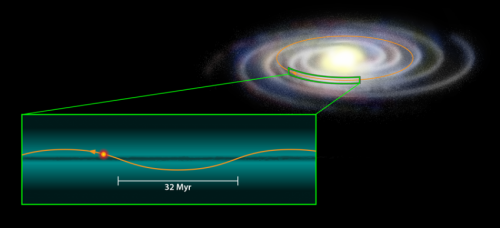May 1, 2014 report
Researchers suggest dark matter disk in Milky Way plane could signal rash of comet strikes on Earth

(Phys.org) —A pair of researchers at Harvard University has published a paper in the journal Physical Review Letters, in which they suggest that a dark matter disk hiding in the Milky Way plane might be responsible for causing asteroids or comets to head our way. In their paper, Lisa Randall and Matthew Reece suggest that such a dark matter disk could pull other bodies from the Oort cloud, some of which could wind up heading toward Earth.
It has been noted by scientists that asteroids and comets tend to strike the Earth in a cyclic pattern that occurs approximately every 35 million—as evidenced by telltale craters. But why such a cycle might occur is still up to conjecture. Some have suggested it's due to a mysterious planet hidden from our view, or perhaps the presence of an as yet undiscovered companion star. In this new effort, the research duo suggests it might be due to the gravitational pull of a dark matter disk residing in the Milky Way Galaxy plane.
This is not the first time that scientists have suggested such a disk might exist—it's been suggested that a dark matter a disk would explain why our galaxy doesn't spin apart. It is the first time, however, that such a disk has been proposed as an answer to why our planet gets bombarded periodically with asteroids or comets.
In their paper, Randall and Reece note that the conventional view of the material that makes up dark matter, wouldn't work as a means of pulling other bodes from where they currently reside, it's evident in their name—weakly interacting massive particles. They suggest that some dark matter could be made instead of what they describe as "strong electromagnetic-like interactions among dark matter particles" which by their nature would exert a greater gravitational pull. And if that were the case, then it would seem plausible that as our solar system circles around the center of our galaxy, most particularly as we move closer to the Oort cloud, some of those bodies that exist there, could be jostled, which in turn could cause some of them to wind up on a collision course with our planet.
This new theory by the research pair has some problems—it assumes the periodicity of crater creation has been firmly established, which it hasn't, and, scientists aren't even sure which craters on the Earth's surface were cause by what sort of object. In any event, the theory is expected to gain or lose credence as the European Space Agency's Gaia mission gets underway—it's supposed to give us a better view of the Milky Way Galaxy than ever before.
More information: Dark Matter as a Trigger for Periodic Comet Impacts, Phys. Rev. Lett. 112, 161301 – Published 21 April 2014. journals.aps.org/prl/abstract/ … ysRevLett.112.161301
ABSTRACT
Although statistical evidence is not overwhelming, possible support for an approximately 35×106 yr periodicity in the crater record on Earth could indicate a nonrandom underlying enhancement of meteorite impacts at regular intervals. A proposed explanation in terms of tidal effects on Oort cloud comet perturbations as the Solar System passes through the galactic midplane is hampered by lack of an underlying cause for sufficiently enhanced gravitational effects over a sufficiently short time interval and by the time frame between such possible enhancements. We show that a smooth dark disk in the galactic midplane would address both these issues and create a periodic enhancement of the sort that has potentially been observed. Such a disk is motivated by a novel dark matter component with dissipative cooling that we considered in earlier work. We show how to evaluate the statistical evidence for periodicity by input of appropriate measured priors from the galactic model, justifying or ruling out periodic cratering with more confidence than by evaluating the data without an underlying model. We find that, marginalizing over astrophysical uncertainties, the likelihood ratio for such a model relative to one with a constant cratering rate is 3.0, which moderately favors the dark disk model. Our analysis furthermore yields a posterior distribution that, based on current crater data, singles out a dark matter disk surface density of approximately 10M⊙/pc2. The geological record thereby motivates a particular model of dark matter that will be probed in the near future.
Journal information: Physical Review Letters
© 2014 Phys.org





















